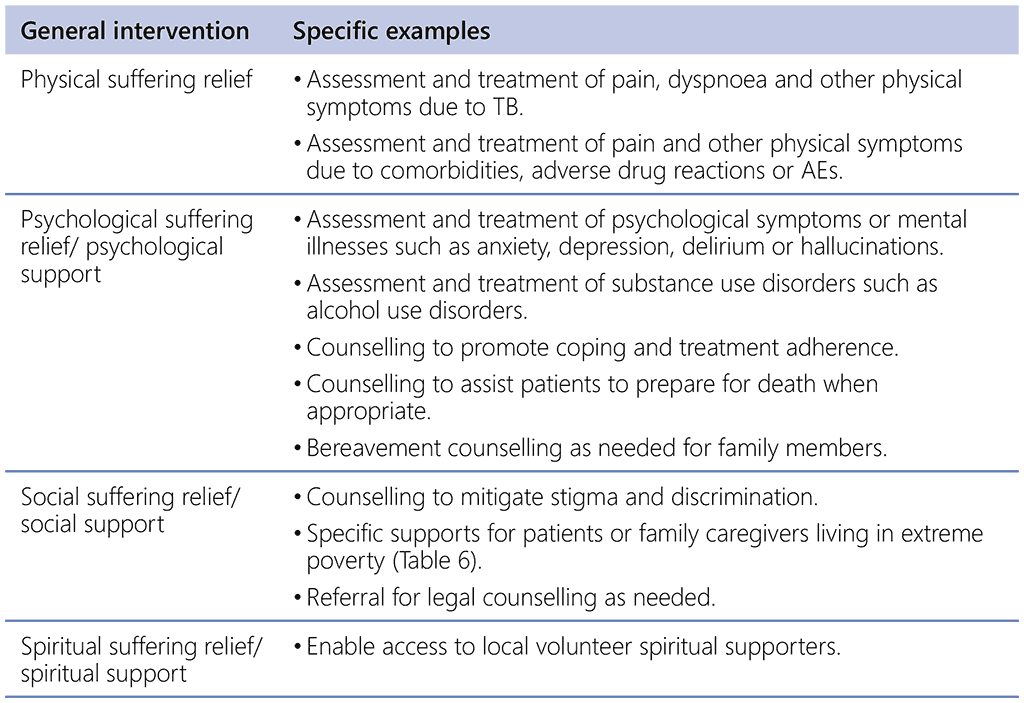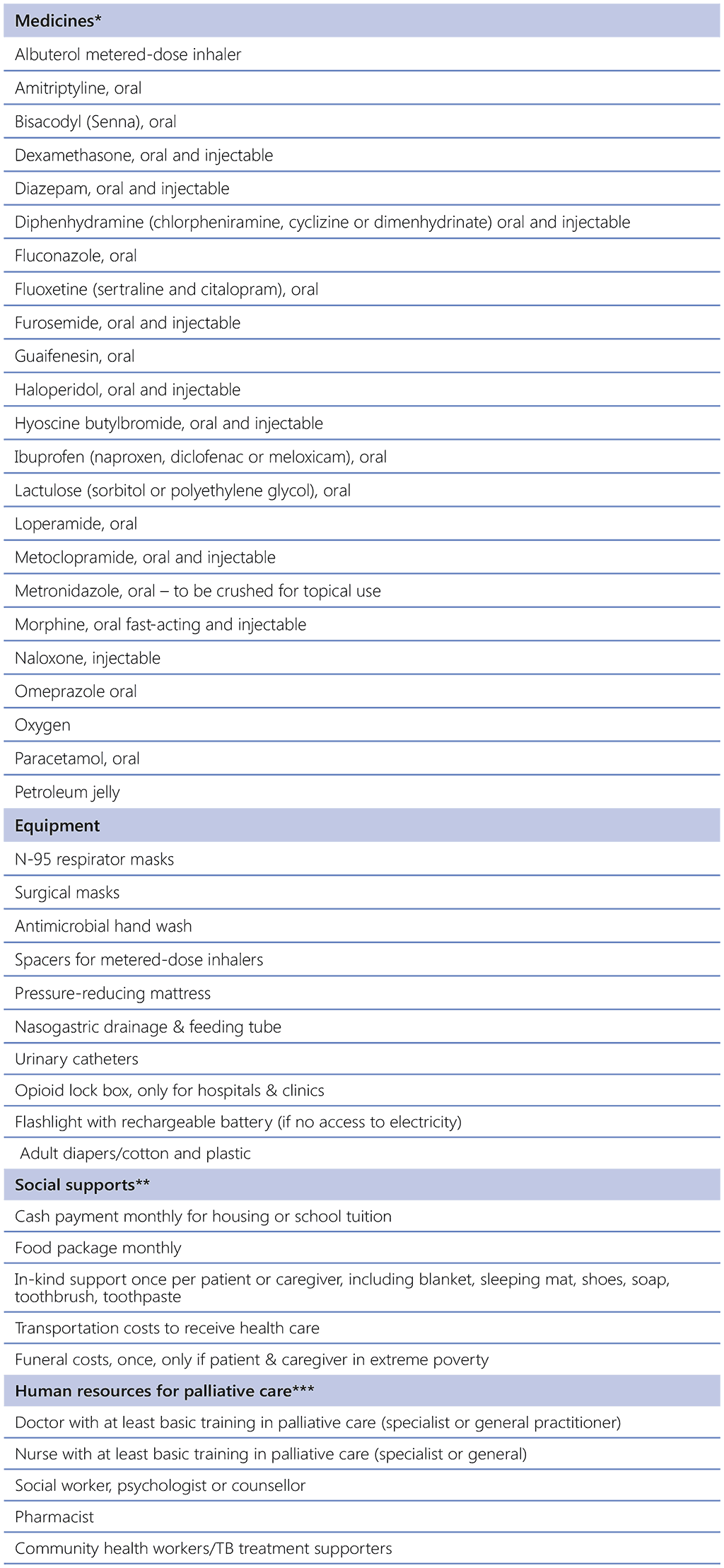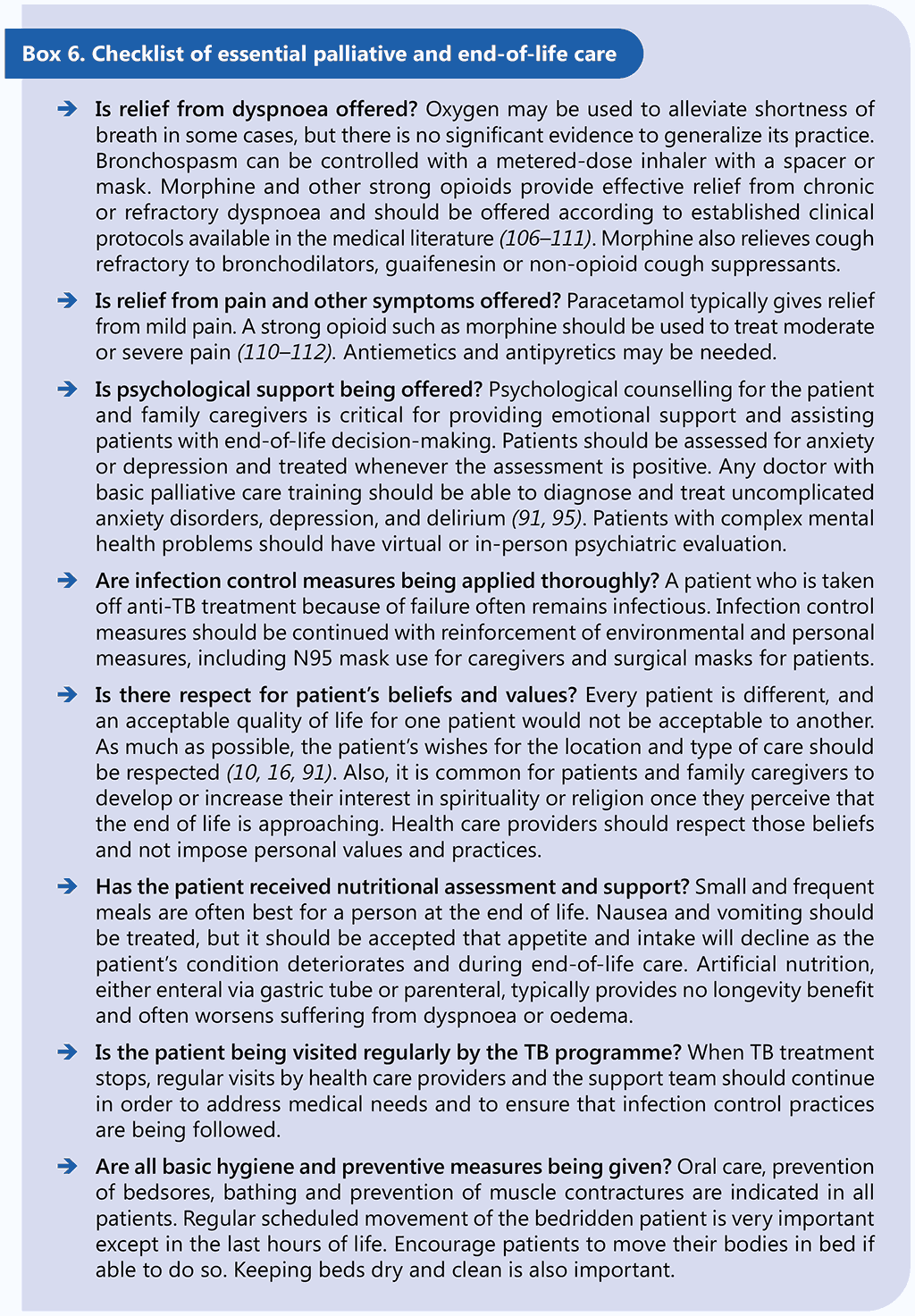Перекрёстные ссылки книги для 1266
Palliative care is the preventing and relieving of the suffering of people affected by TB during and after treatment and at the end-of-life.
Many people with TB, and most with DR-TB, suffer in multiple ways: from physical symptoms such as pain or dyspnoea, from psychological symptoms such as anxiety or depression, and from social problems such as discrimination or homelessness. This suffering may be due to the disease, its treatment, physical or psychological comorbidities such as HIV/AIDS, diabetes, or mental health/substance use disorders, stigma and discrimination, or extreme poverty (91, 92). People continue to die from both DR-TB and DS-TB (93), and their family members may suffer from the stress of caregiving, financial challenges, further stigma and grief (91).
6.1 What is palliative care?
Palliative care is the prevention and relief of the physical, psychological, social and spiritual suffering of adults and children with serious illnesses and psychosocial support for their families (94, 95). The prevalence, types and severity of suffering of people with TB vary by geopolitical situation, socioeconomic conditions, culture, accessibility of primary and specialized health care, and the susceptibility of their TB to anti-TB medicines. Attention to local needs is necessary for palliative care services to be person-centred: tailored to local needs and to the needs of individual patients and families (94, 96).
6.1.1 Why is palliative care an essential part of comprehensive TB care?
WHO’s End TB Strategy has a vision of zero suffering (13). Based on this vision alone, palliative care is an essential part of comprehensive care for people with TB (13, 91, 94, 97). In addition, World Health Assembly Resolution WHA67.19 from 2014 and the WHO Ethics Guidance for the implementation of the End TB Strategy state that palliative care is “an ethical responsibility of health systems and that it is the ethical duty of health-care professionals to alleviate pain and suffering, whether physical, psychosocial or spiritual, irrespective of whether the disease or condition can be cured”. (16). They also state explicitly that palliative care is a core component of the human right to health, and of comprehensive care for people with DR-TB (16, 94). Palliative care not only can alleviate the suffering of patients with TB but also may improve treatment outcomes and protect the community by helping patients adhere fully to treatment (91, 92).
6.1.2 When and where should palliative care be provided for people with TB?
An initial assessment for suffering related to TB should be done at the time of diagnosis. Palliative care should be initiated immediately as needed and should be combined with TB treatment to relieve any suffering due to the disease, to the adverse effects of treatment, to comorbidities or to social problems. It is especially important for people with DR-TB (98). Tailored to the patient’s needs, palliative care should continue regardless of whether the cure is expected or whether treatment fails. It should be available at all levels of the health care system (94–96), namely:
- TB and lung disease hospitals and general hospitals with TB units;
- district hospitals;
- TB clinics in the community;
- patients’ homes.
Even when a patient recovers from TB disease, all the medical effects of TB may not be resolved. People that survive TB may have long-term impairment from TB disease (99–102). People who had bone or neurological infections may continue to have problems related to bone damage or neurological issues. It is also becoming more and more recognized that even people who had pulmonary TB may have serious long-term medical problems resulting from lung damage resulting from TB. Studies find that a majority of patients report respiratory symptoms after completing TB treatment. Patients may have continued shortness of breath, cough, decreased lung function, bronchiectasis and recurrent bacterial pneumonia. They may also develop heart failure due to lung damage. These symptoms often continue to affect their daily lives. Although many people improve with time, a significant number continue to have symptoms, and their symptoms may even worsen with time.
It is important to continue to monitor the health of TB patients even after they have finished their medications for TB disease. They may need to be followed by a lung or heart doctor to help treat ongoing symptoms. They may benefit from palliative care which can offer treatments to help with their symptoms such as shortness of breath, swelling from heart disease, pain and psychiatric care to help patients who are facing long-term health problems.
6.1.3 Who should provide palliative care for people with TB?
Most palliative care can and should be provided by TB and lung disease specialists, primary care doctors and nurses with at least basic palliative care training (30–40 hours of training), TB treatment supporters and community health workers trained to recognize and report uncontrolled suffering, and by social workers and psychologists (91, 92, 94–96). Ideally, specialist palliative care doctors should be available to treat patients with refractory or complex suffering and also as supervisors, consultants and teachers.
6.1.4 What is end-of-life care for people with TB?
End-of-life care is palliative care for patients whose curative treatment options have been completely exhausted. When failure of all curative options is suspected, it is imperative that careful plans be made both:
- to suspend all non-beneficial anti-TB therapy, and
- to commence end-of-life care combined with infection control.
These plans are crucial to maximize the patient’s comfort and quality of life, help prevent transmission and protect public health.
6.2 Planning and implementing palliative care for people affected by TB
6.2.1 Integration of palliative care into NTPs
Most people with DR-TB, and many with DS-TB, have palliative care needs. Yet palliative care is in general not widely accessible in high TB burden countries (103). Wherever palliative care services are not yet accessible, the NTP may need to take the lead in planning and implementing them (16). If possible, official collaboration should be established between an existing palliative care programme and the NTP (104). Plans for TB palliative care should include the following:
- a list of palliative care interventions (Table 5);
- an essential package of palliative care (medicines, equipment, social supports, human resources) (Table 6);
- the estimated number of patients to be served;
- models of care that are responsive to the needs of patients;
- regulations to assure access to essential medicines for palliative care;
- M&E; and
- sustained funding to cover the costs of the operation (91).
Table 5. Palliative care interventions needed for people with TB

6.2.2 Essential package of palliative care for people affected by TB
The essential package of palliative care for people affected by TB consists of a set of medicines, simple equipment, social supports and human resources (Table 6). Adapted from the WHO essential package of palliative care for primary care (95), it is designed to be safe and effective for preventing and relieving all types of suffering associated with TB (Box 6). The package includes only inexpensive and readily available medicines and equipment, and its use requires only basic palliative care training (30– 40 hours). Consequently, this package can and should be made accessible everywhere, including for the rural poor. The medicines include: at least one non-opioid analgesic, opioid analgesic, anti-pyretic, anti-emetic, anxiolytic, antidepressant, antihistamine, anticholinergic, antifungal and anti-diarrhoeal agent; as well as a bronchodilator, corticosteroid, diuretic, expectorant, laxative, neuroleptic and proton pump inhibitor.
Table 6. Essential package of palliative care for people affected by TB (91, 105)

* Based on WHO Model List of Essential Medicines, 2019. In parentheses () are acceptable substitutes where the primary recommended medication is not available or is expensive.
** For patients who qualify on the basis of financial need.
*** Staffing will vary depending on the level of the health care system (referral hospital, provincial hospital, district hospital, community health centre, or home). Staff members of palliative care centres or wards may provide palliative care full-time. Others may provide relief of suffering combined with TB treatment most of the time and may provide end-of-life care only when needed. All staff members should be trained to practise and teach infection control.
6.2.3 Oxygen for relief of mild dyspnoea
Oxygen therapy may provide relief from mild dyspnoea and sometimes at least partial relief from moderate dyspnoea. It should be accessible at least in TB hospitals and wards. Whenever possible, it also should be accessible in the home.
6.2.4 Morphine for safe relief of chronic or refractory dyspnoea
Strong opioids such as morphine have been proven to relieve safely and effectively not only pain but also dyspnoea that is refractory to oxygen therapy and treatment of the underlying cause (106–112). Morphine is the most studied and least expensive strong opioid and is widely available on the world market. Consequently, morphine, in both oral fast-acting and injectable preparations, is the most essential of the essential palliative medicines for people with TB (106, 107). Misconceptions about the use of opioids held by health care workers and caregivers result in unnecessary suffering from pain and chronic or refractory dyspnoea and perpetuate unethical medical practices (108). NTPs should work with the officer responsible for controlled medicines at the health ministry to ensure that these morphine preparations are accessible for TB palliative care at least in TB hospitals and wards, and ideally also at TB clinics, according to international standards (91, 94, 106, 107, 109–112).
6.2.5 Palliative care teamwork
Palliative care is best provided by a multidisciplinary team whenever possible (104). The ideal palliative care team includes a physician, nurse and psychologist or social worker. TB treatment supporters, community health workers or volunteers can be trained and supervised to visit patients at home, to provide emotional support, to recognize and report inadequately controlled suffering or inappropriate use of opioids, and to practise and teach strict infection control (91).
6.2.6 Management of substance use disorders and other comorbidities
People affected by TB are often also affected by other medical conditions such as HIV/AIDS, diabetes, hepatitis, chronic lung disease, neurological disease, substance use disorders and other mental health problems. Some of these illnesses and disabilities may by themselves contribute to an increased risk of death among people with TB while on treatment and afterwards. When creating TB palliative care services, the prevalence of serious comorbidities in the target population and the associated types of suffering should be estimated and preparations should be made to address them. Mental health disorders may worsen when TB patients learn of a poor prognosis. Therefore, all TB patients in need of palliative care should undergo an assessment for mental health disorders.
Alcohol use disorder and injection drug use are risk factors for poor DS-TB and DR-TB treatment outcomes and many other problems (113–115). Treatment of alcohol use disorder and opioid use disorder can and should be integrated with comprehensive TB care and treatment (116, 117). WHO guidance on task-shifting, training and supervision of human resources for palliative care is provided elsewhere (104). Task-shifting to enable effective community-based treatment of alcohol use disorder has also been demonstrated (118, 119).
6.2.7 M&E of palliative care for people affected by TB
Palliative care for people affected by TB should be monitored and evaluated to help assure its accessibility and quality (104, 120, 121). The following two outcome indicators are recommended:
- Number of patients with TB in the previous reporting period/year for whom all attempts at curative treatment were deemed to have failed.
- Number of patients with TB in the previous reporting period who received morphine (oral fastacting or injectable) for symptom relief.
The following process indicators are optional but also suggested:
- Is there a national TB policy strategic plan that includes palliative care? (Yes / No / NA)
- Is morphine (oral fast-acting or injectable) available in public TB hospitals or wards (Yes / No / Unknown) (available in over 50% of TB hospitals or wards)?
6.2.8 Cost savings from palliative care integration into TB programmes
The essential palliative care package need not increase the cost of the routine TB care and treatment significantly, if at all. There is growing evidence that palliative care integrated into health care systems and including home care can save money for these systems by reducing hospital admissions near the end of life and the length of stay in hospitals (92, 105, 122–125). For patients not expected to survive, a one-time expense may be necessary to refurbish rooms either in institutions or in the home to ensure infection control. Palliative care has also been shown to provide financial risk protection for patients and families (92, 126, 127).
6.3 End-of-life care for people with TB
6.3.1 When should suspension of TB treatment be considered?
TB treatment often consists of an initial treatment cycle and, if no response is seen, it is necessary to reassess the regimen and treatment plan as well as to formulate a new plan of action. Suspension of drug therapy is recommended in cases where the medical personnel involved are confident that the patient has been adherent to the prescribed regimen, the patient is on the correct regimen with respect to drug sensitivities (e.g. the patient is not on a DS-TB regimen if they may have DR-TB) and there is no possibility of offering another effective therapy (61). In patients who have no therapeutic options, there is a medical, moral and public health obligation to continue providing care to the end of life with proper infection control (91, 103).
6.3.2 Important considerations in suspending TB treatment
There are at least three important considerations in suspending anti-TB therapy:
- Doing no harm: The medicines used to treat TB, and especially DR-TB, have significant adverse effects. Continuing them while the treatment is failing may cause additional unnecessary suffering and create false expectations in patients and families.
- Public health: Patients in whom DR-TB regimens fail are likely already to have highly resistant strains, and ongoing therapy can result in resistance to even more medications. The resultant highly resistant strains could subsequently infect others and be extremely difficult to treat. In addition to the creation of further resistance, continued treatment in this situation also uses resources that may be very scarce. Thus, in general, treatment should be discontinued in this situation. However, if there is no clinical deterioration and the clinician prefers to continue the regimen, strict respiratory infection control is critical.
- Non-abandonment: Provision of palliative and end-of-life care is imperative to optimize the quality of life with proper TB infection control (16, 91).
6.3.3 Decision-making about suspension of TB treatment
If suspension of DR-TB therapy is considered, there should be discussion with the entire clinical team – including the patient and all physicians, nurses and health workers or TB treatment supporters involved in the patient’s care. If the clinical team decides together that treatment should be suspended, a clear plan should be prepared for approaching the patient and the family. This process usually requires personal interaction with patient and family, ideally including home visits, and may take several weeks. It is not recommended to suspend therapy before the patient understands and accepts the reasons to do so, agrees with a change in goals of care to optimizing quality of life and comfort, and accepts palliative care. It is crucial that care continues and that the patient not be abandoned

6.3.4 Providing end-of-life care for people with TB
End-of-life care can be provided either in an inpatient setting (hospital or hospice) or in the home depending on: the preference of the patient; the willingness of the relatives and community to provide home care; the presence of a medical need for inpatient care; and the existing capacity for proper infection control in each setting (91, 122). Palliative home care combined with strict infection control may be preferred by many patients and may be less expensive than institutional care for health care systems. Patients could be with family and friends rather than isolated in an institution that may be far from home. Those who are well enough may be able to engage with family in income-earning activities such as crafts or Internet-based businesses. However, adherence to infection control measures should be a prerequisite for remaining at home. TB programmes should explore opportunities to collaborate with local palliative care programmes to provide palliative home care for people with TB. In addition, TB programmes should build basic capacity for the estimated number of patients in need of institutionally-based end-of-life care either for medical reasons or because of the lack of relatives or community members willing to provide home care.

 Обратная связь
Обратная связь